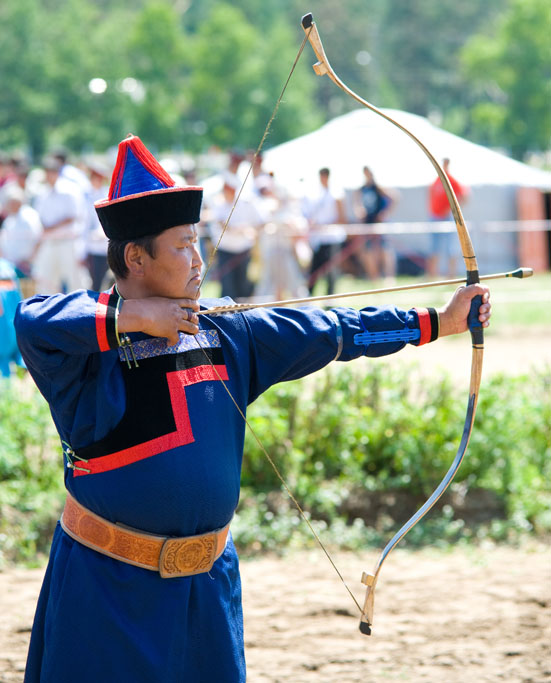
Considering Mongolia is the world’s 2nd largest landlocked country with thousands of years of history it is perhaps unsurprising that there are more than 20 different ethnic groups living here in harmony. Each has their own unique identity and history of how they became who they are and how they came to live where they do.
We have chosen 8 different ethnic groups and the symbolism of their costume designs to present you today. These are Torguud, Bayad, Zakhchin, Buriad, Kazakh, Dariganga, Uriankhai and finally the Khalkh that make up the majority of the population in Mongolia.
Torguud
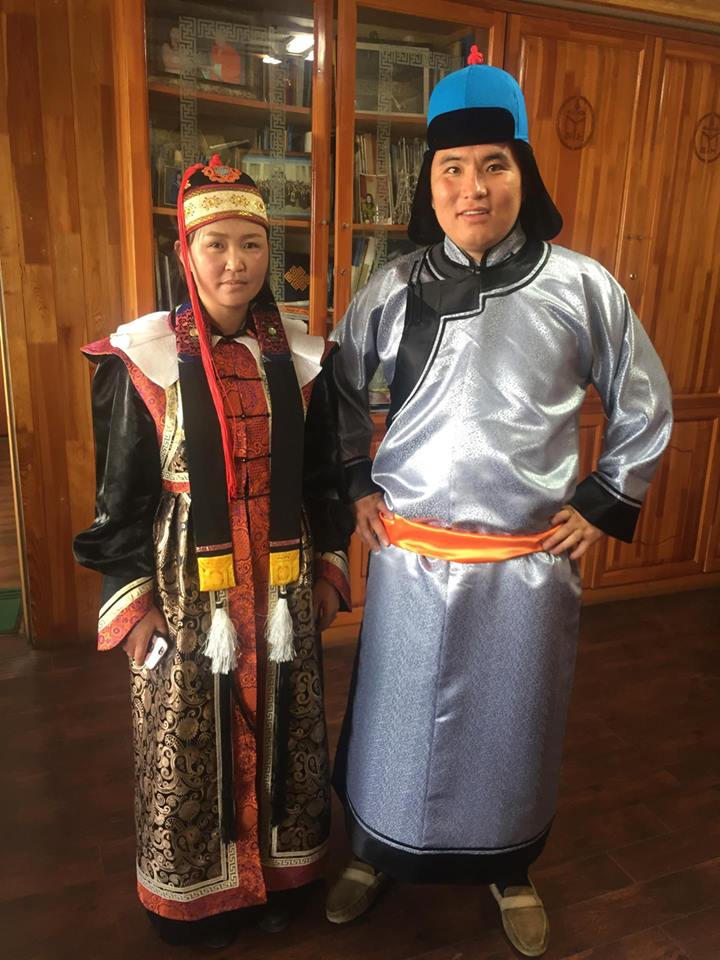
The Torguud are a small ethnic group with a population of about 15,000 mostly living in the town of Bulgan in Khovd, the westernmost region of Mongolia. This clan is descended from the most feared and respected soldiers of the Mongolian empire. In the 14th century King Van of the Khereid clan created a group of special soldiers and mad ethem and their families responsible for the internal security of the Mongolian empire, he named this group, Torguud. After many years this group have developed their own identity and culture and are now considered a separate ethnic group in Mongolia.
Torguud man’s costume:
-The Torguud man’s costume has not changed for many years. The costume is similar in someways to other ethnic groups’ clothing such as Zakhchin, Dorvod, Bayad, Uriankhai but is unique in its own way.
- The Torguud man’s winter deel has a reversible collar with black corners and slim embroidery, Mongolians call this “Tojoo”. On the hip of the deel there is a square frame with balck treads and a coupe of horizontal lines each 2 fingers wide. In the winter men wear a lambskin deel with long sleeves. In summer they wear a deel with similar decoration but made with a lighter material in blue, white and beige colours.
- Torguud mens’ hats are called “Khalvan”. The winter hat has a nubbin on the top with threads, straps to tie under their chins and a long red strip that reaches down to their waists. Children and young people wear lambskin hats called “Jatag” in winter.
- “Jatag” hats have blue square top with a 4-cornered red nubbin. In the front there is a cushion and there are earmuffs on the side. Sometimes there is a thin green veil on top of the doule red veils hanging in the back. The hat has 4 sides, which resembles assosation of 4 Oirad tribes. The stiff materal and vertical treading of the hat makes it stand tall.
- Torguud men used to wear a silver earring in their left ear and a large decorative ring on their finger.
Torguud women’s costume
- Torguud women wear a sleeveless outer jacket called a “Tsegdeg”. This is a ceremonial jacket worn mainly for special occasions. The inner, lighter deel is called a “Lavshig” and is usually made of blue, navy, black and green silk. The inner collar of the lavshig is made of white cotton and can be taken out for cleaning. Originally the white cotton used to cover the whole of the outside of the deel like a cape but over the years it has become a small decoration due to changes in lifestyle. The purpose of the white cape or collar is to protect woman from father sky. Torguud and Oirad people worship the colour white and call it “Gylaan”.
- The woman’s round hat is called a “Toortsog”. It is decorated with pearls, corals and patterns. In the front of the toortsog you will see a round pattern with a moon shaped coin iniside, this is called Zendmen. This decoration is usually made out of silver and is meant to call good fortune to the owner of the hat. The top of the hat consists of a coral button, red tassels, a black silk body and golden wrap with red rim. The richer the owner the more coral is used when decoration of the hat.
- A special type of hair ornament worn by married Torguud women has silver decorations, cololurful patterns and corals. In the olden times they also wear silver chocker around their neck.
Bayad
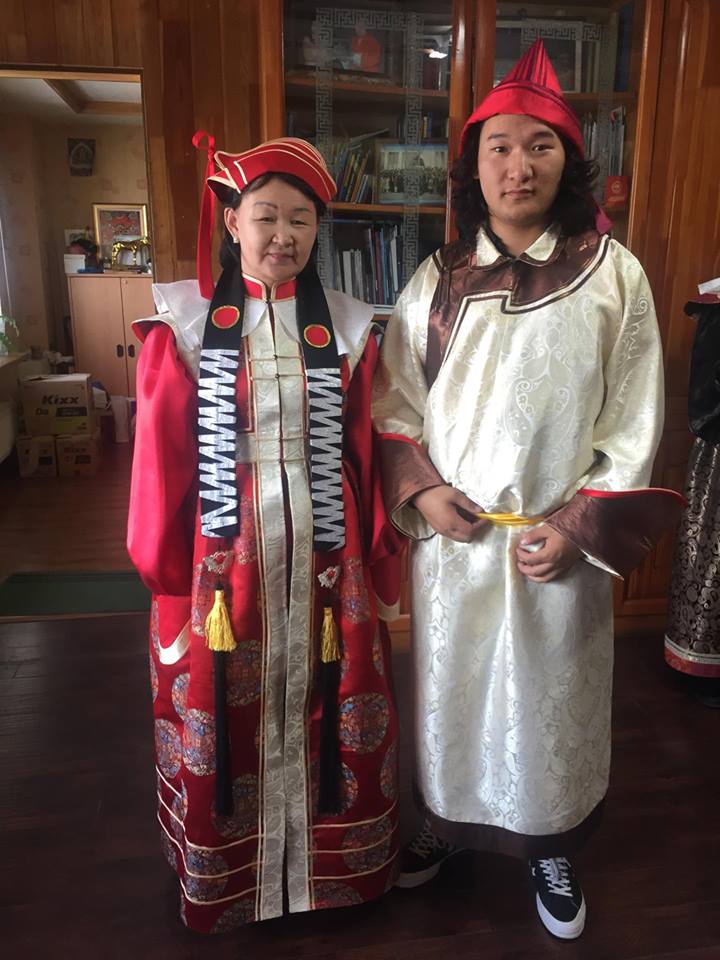
- The Bayad are the third largest ethnic subgroup in Mongolia with about 57,000 people in total.
They are one of the Four Oirat tribes and planed an essential role in building the Mongol Empire.
The word Bayad literally means “rich people” with the name dating back to the time of the ancient Hunnu, ancestors of modern Mongolia.
Nowadays most Bayad people live in the western Mongolian province of Uvs, the Gobi province of Dundgovi as well as inner Mongolia and Russia.
- Bayad peoples’ clothing can be broken down into 5 categories: men’s, women’s, children’s, wedding clothes and clothing for older people.
Bayad men’s costume
Bayad Men mostly wear white, leather deels with black trim and a slit on both sides. At the top of the slit there is a pattern called “Ulzii”. The front of the deel usually has black lamb skin stitched inside which is displayed when the deel is worn unbuttoned. The leather used to make the deel is tanned with a traditional smoking technique before being stitched onto red, green or black silk.
Bayad women’s costume
-Married Bayad women wear red or burgundy deels with a white collar, which is usually 2 fingers wide. Horizontal lines are embroidered on the skirt, which has very wide arms and overhanging sleeves. Similar to the Torguud cosutume, a Bayad woman’s deel’s white collar symbolises their body and is meant to protect them from bad luck and represent purity.
-They wear both an inner and an outer deel. The outer deel is called an “Uuj”, has hard shoulder pads and no slit in the back.
They traditionally wear their hair with a black hair ornament that is decorated with a silver butterfly and black tassles.
Zakhchin
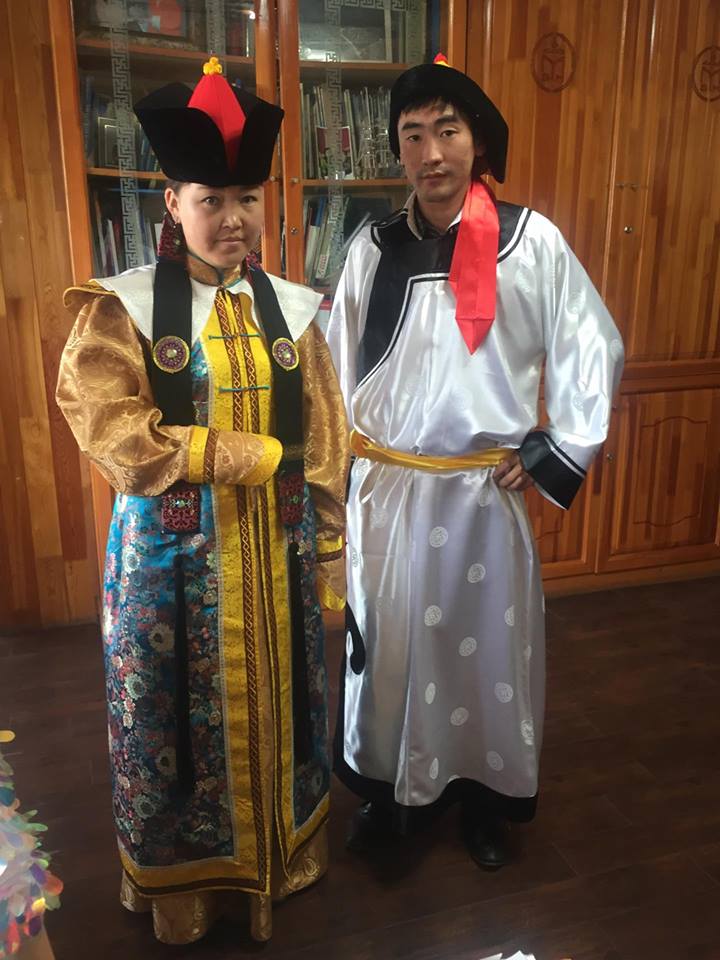
There are about 33,000 Zakhchin people in Mongolia. The name Zakhchin means people who live by the border. Nowadays they mostly live in the western Mongolian province of Khovd but in the first half of the 17th century Zahchin people used to live along the south and eastern borders of Mongolia. This clan was created from the best soldiers of the Torguud, Dorvod, Uuld as well as other ethnic groups along with their families and they were commanded to protect the Oirad peoples from Manchuria. It is thought that 2000 Zahchin individuals were selected from around 30 different ethnic groups.
- Not long after the Zakhchin clan was formed, they were attacked by the Manchurians. Their governer was killed in the attack along with most of the group and those that survived were forced to move to the south west of Khovd province where thet have stayed until now.
- Zakhchin people are well known for their good sense of humour and a traditional dance called “Bii Bielgee”
This dance, popular among all western Mongolians, is a unique form of art that has been performed for hundreds of years to represent Mongolian nomads’ daily life, culture and traditions. The dancer moves every part of his or her upper body to create movements that resemble water, wind, riding a horse, milking livestock and so on.
Zakhchin women’s costume:
Zahchin man and woman both wear the same hat, which is called “khalban”. Similar to the other ethnic groups of west Mongolia Zahchin women wear white inner collared deels, however their outer deel, or Uuj, has a slit in the back and more prominent shoulders.
Buriad
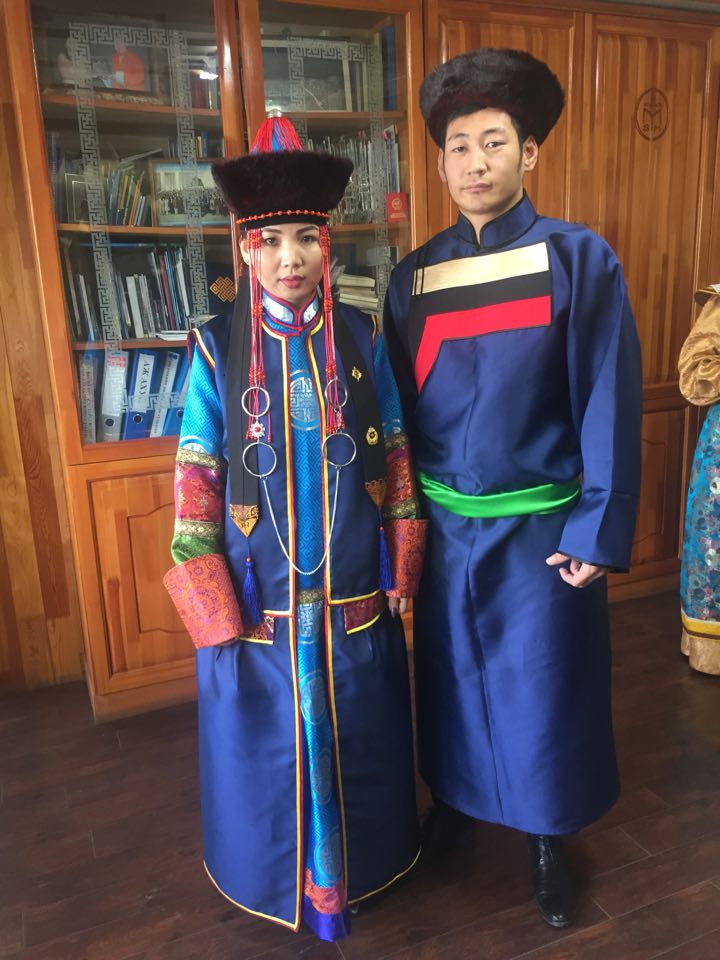
The buriad are the largest subgroup in northern Mongolia and Siberia withabout 46,000 Buriad people living in Mongolia today. The name "Buriyad" is mentioned in the book, the Mongolian Secret History where they are first described as forest people. Since ancient times they interacted closely with Mongolians, huntin wild animals and herding livestock in the Siberian forests. It is believed that they originated from three ancient clans called the Horid, the Tumed and the Barguud who lived on the southern shore of Baikal lake.
Buriads mostly live in houses and their main means sources of food are hunting, raising cows and some basic crops. They are famous for their milk processing techniques which they use to make make clotted cream, jams and to bake bread. They are also known for their songlike conversations, fierce debating, dancing and storytelling.
When Baikal Lake was part of Mongolia many Buriad people lived there but when Russia absorbed Baikal into their territory in 1795 about 5,500 Russian farmers moved to the area. Because of intensive farming the nomadic and herding Buriad people had to move to Mongolia to survive.
Buriat men’s costume:
The front flap of a Buriad man’s deel has a sharp corner with 3 brightly coloured stripes, which altogether represent the highest, lowest and middle sky spirits. All deels must have the 2 colours - red and black - to represent the death, sorrow and pain of Buriad people from the past but the 3rd stripe’s colour depends on the gender and age of the owner.
- Their hat has 11 vertical, quilted stripes representing the 11 clans of the Buriad tribe such as the Tsagaan khul, the Hargana and the Bodonguud to name but three. On a side note each of these clans has their own god and specific religious practices although they are all related. The Buriad hat is longer at the front than the back and has flaps that can be extended when it is cold outside. Some Buriad hats are embroidered with patterns that look like mountains, suns and flames. On the top of the hat there is button with red tussles spreading in every direction. There are also other types of Buriad hat such as fur hats with ear-muffs and a special, high top hat.
Butiad women’s costume:
- A distinctive element of the Buriad women’s deel is the elbow detail, which is wide and made with colourful silk. The slit of the outer deel, the Uuj, is at the back and it begins where the fold ends. The rear fold of fabric is also made of different coloured silk.
-The married women’s deel is constructed of several distinct pre-cut pieces of cloth including single pieces for the front, the back, the chest, midriff and the skirt. The borders of the top flap are thin but the inner and outer edges of the skirt are made of a thick, dark material.
- There are 3 folds on the back of sholders of the deel. A single botton is sewn onto the collar and another under the arm with another 2 buttons on the front for fastening the deel.
-The back of the skirt and the chest of the deel are usually made of cotton but the front of the skirt is made of silk.
Kazakh
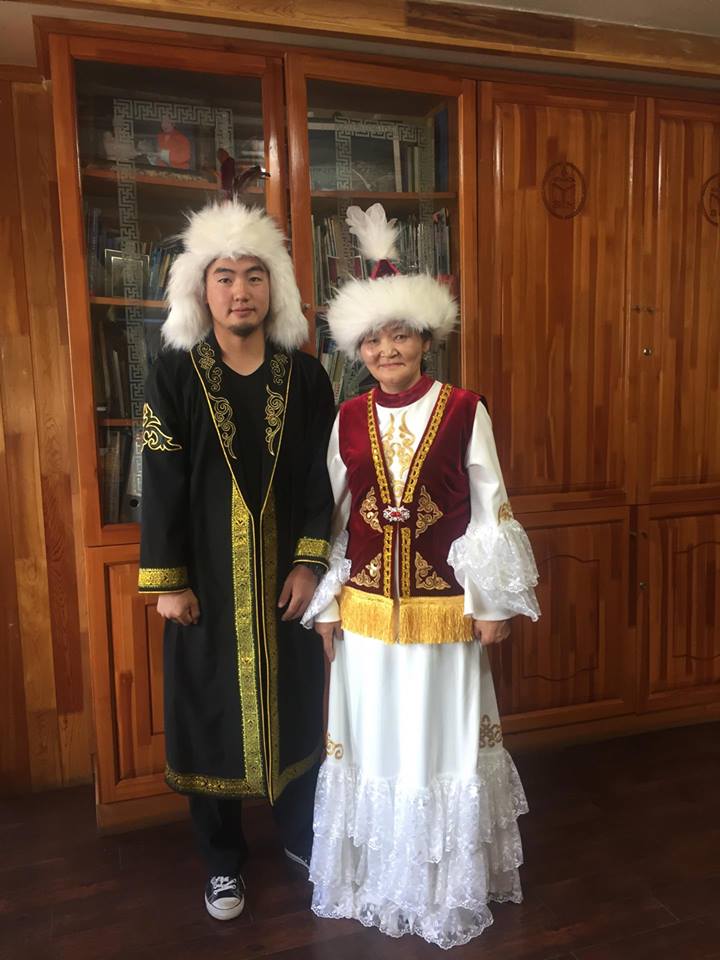
In 1875 the first 20 Kazakh families moved to Mongolia from Shinjan in China. By 1911, when the Bogd Khaan was still the head of the Mongolian state, there were 21,000 Khazakh people in Mongolia but in the 1930s a large number of Khazakh people escaped to Mongolia from the Altai mountain range of China. On the 9th of June 1938, the Mongolian government officially accepted the Kazakh people as a subgroup of the state and set aside Bayan-Ulgii province for them in 1940. Today Kazakh people still mostly live there, in the western border area of Mongolia.
Kazakh people have very a distinctive culture and set of traditions compared to the other Mongolian ethnic groups. As an example, Kazakh women are not supposed to marry outside of the Kazakh ethnic group whilst other groups maybe encourage this. However, a Kazakh man is generally allowed to marry any woman from another ethnic group, as long as she converts to Islam, and this is a highly celebrated event.
-Kazakh people have great respect for their elders and widowed parents can choose to live with any of his or her children. Usually they choose to live with the poorest child of theirs because the rest of the siblings will provide their parents and the host child with food and clothes until they die.
- Kazakh people and their guests wash their hands everytime before and after supper. The youngest member of the family will pour the water on everyone else’s hands.
- If you visit a Kazakh family they will serve you tea and keep refilling your cup until you cover it with your full hand to say thank you. Also, any guests to a Kazakh family that arrive before sunset will be treated with great respect but if those who visit after sunsetdo not receive the same level of formal hospitality.
Kazakh men’s costume:
Traditional Kazakh costume has changed considerably over the years. Until the 2nd century BC they wore clothes made from the skins of wild a nimals. Later they started using leather made from the skin of farm animals as well as silk, velvet and other synthetic materials, these synthetic materials were mostly used for decoration. By the end of the 19th century the Kazakh people had come under the influence of various cultures including the Tatars, Russians, Tureg and other central Asian ethnic groups and so they were mostly wearing cotton clothes.
- Kazakh men’s deels are mostly black with white sprawling patterns embroidered along the edge.
- Kazakh men often wear fur-trimmed hats.
Kazakh women’s costume
There are 2 parts to a Kazakh women’s costume, the dress and the blouse. The dress has fluffy skirts with ruffles below the waist and is called a “Kalek”.
- The design of the costume differs depending on the age and marital status of the owner. For example: young girls wear ruffled dresses with patterns on the skirt and fore arms as well as brightly oloured waistcoats. Kazakh women’s hats are called “Takiya” and feature a tall cone with pearl decorations and feathers. Women and girls costumes are similar up until the point that they are married. At their wedding women will wear a veil of between 25 and 70 centemeters in length from the top of their hat. Once they are married women wear white cotton, wrapped around the top of their head.
- Kazakh women wear a type of trousers underneath their dresses called “Dambaev” and in winter the wear jackets are called “Shapan”. The Shapan has long sleeves, a long straight design and is decorated with traditional Kazakh patterns.
Dariganga
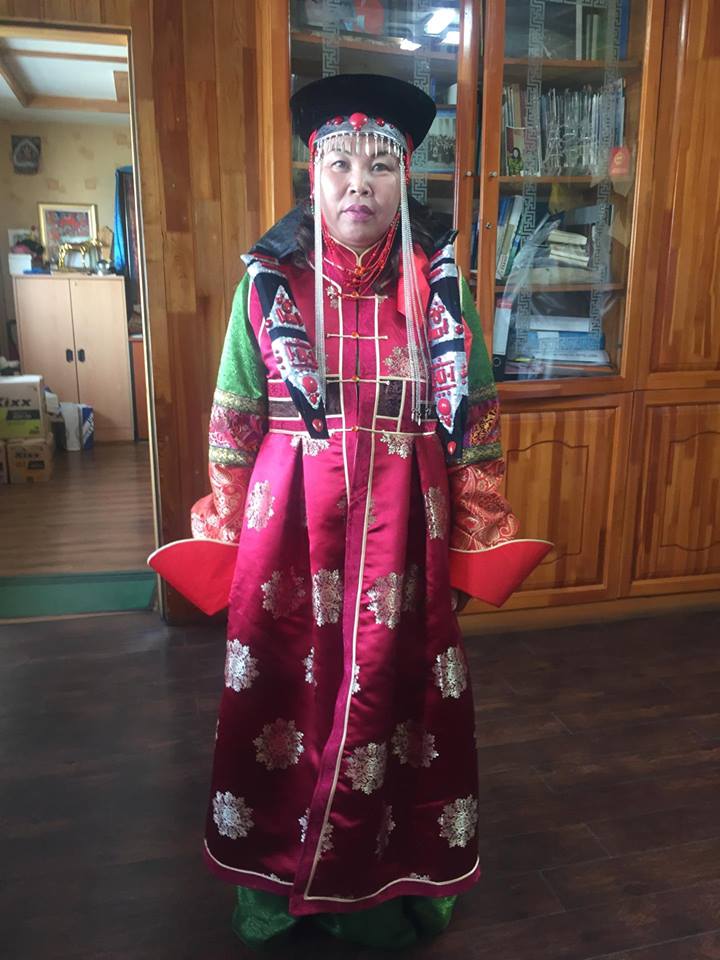
During Manchurian rule in 1690, a group of Mongolian families were selected to look after the Mongolian state’s best horses. They were relocated to Dari Carin near Ganga Lake and so they became known as the Dariganga. Since then they have developed a sufficiently unique culture, tradition and dress to be identified as an individual ethnic group. In terms of language they speak a dialect similar to that of the Khalkh Mongolians.
- Today they mostly live along the south east Mongolian border in Sukhbaatar province. There are currently about 28,000 people in this subgroup.
- Dariganga people are well known for their fast horses and beautiful silver crafts. In
the past they were paid in silver for their horse work and over time they developed great skills in silver craftsmanship and still make very beautiful and unique silver items.
Dariganga women’s costume:
- Similar to Khalk Mongolians, Dariganga women wear both an inner and an outer deel. The outer deel has wide and long sleeves made of bright silk. The outer deel opens in the front and features a flared skirt.
-They are mostly decorated with red coral designs mounted on silver. The main ornament they wear is called a “Tatuur” which consists of 3 thin silver chains hanging from each side of the head, a silver front with corals or pearls, acoral ties underneath the chin and 2 hair ornamenta hanging down in front of the deel.
Uriankhai
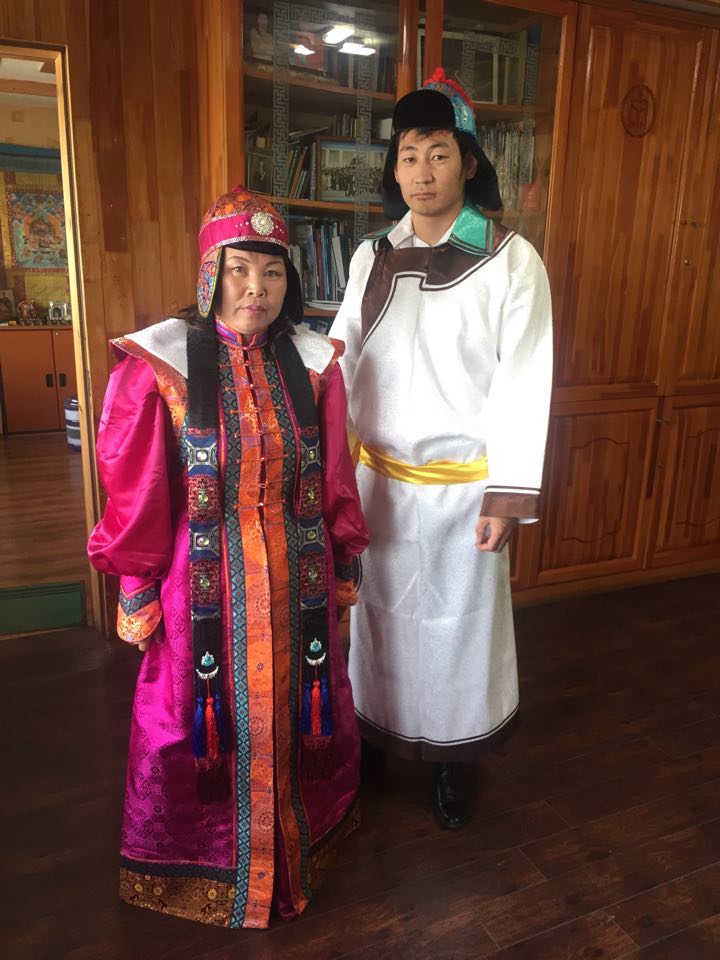
There are about 27,000 Uriankhai people in Mongolia. Their ancestors were hunters living in the forested areas of north and west Mongolia. During the 13th century they divided into the Western Uriankhai and the Forest Uriankhai. They were further divided into 5 battalions of soldiers during Chinggis Khan’s time with one group tasked with protecting the “Ikh Khorig” settlement of the Mongolian royal family in the Khentii Mountains.
Most of the Uriankhai people are originally descended from the Mongolian Khalkh and Oirads as well as Turkish people. After the fall of the Yuan dnasty the Uriankhai people spread across the country with some joining Oirad tribes, some joining the Eastern Mongolian clans and yet others being absorbed into Khalkh and inner Mongolian groups.
Currently Mongolian Uriankhais mostly live in Gobi Altai, Khovd, Khentii, Selenge and Bayan- Ulgii provinces.
Uriankhai men’s costume:
The men usually wear white deels in their day to day lives. These are decorated with wide black spiral patterns above the side slit. The rest of the deel edges are bordered with black material as well. Their winter deel has a lambskin flap at the front.
Uriankhai women’s costume:
Uriankhai women wear hats with long earmuffs and a deel with wide sleeves. The earmuffs can be worn up or down depending on the weather. Their outer deel has shoulder pads that stick out and a slit in the back. The chest area of the outer deel is wide and the front edges are decorated with colourful, red ribbons. Their deels are usually made with brown, purple and blue silk and the outer deel’s white collar is bendable. The arm of the deel has long sleeves with wide cuffs.
Khalkh
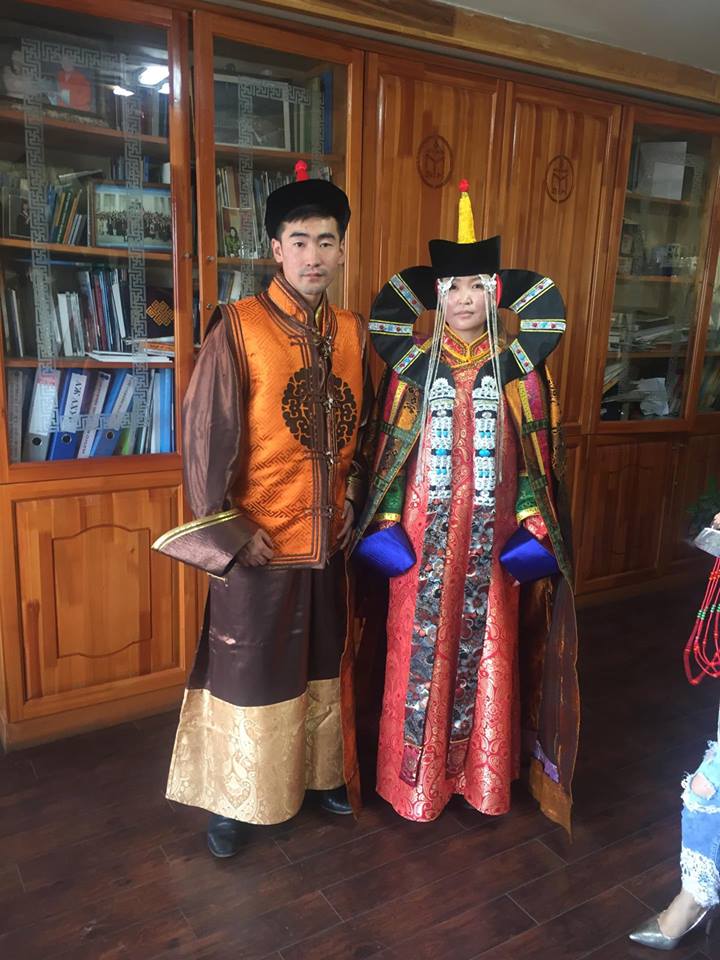
The main ethnic group in Mongolia is the Khalkh people who make up more than 80% of the Mongolian population. The ancestors of Khalkh Mongolians lived along the banks of the Kherlen, Onon and Tuul Rivers where the Mongolian Empire was founded in the 13th century. Batmunkh Dayan Khaan, a descendant of Chinggis Khaan, drew the Khalkha Tumen people from the Mongols residing in the region of present-day central Mongolia and the most northern part of Inner Mongolia in the 1500s.
In the fight to gain indendence from Manchuria in the years of 1911 and 1912 as well as the revolution of 1921, Khalkhs played a main role in leading the country. Ancient Khalkh society was based on kinship traced through the paternal line and was organised into clans and tribes. The 4 subgroups of the Khalkh people are the Eljgen Khalkh, Eevenhen Khalh, Central Khalkh and Borjigon Khalkh. Leadership was determined on the basis of ability so these ancient societies were a form of early meritocracy. Married sons usually lived near their fathers and other male relatives.
Traditionally, most Khalkha lived in gers as nomad, moving four or five times a year from one pasture to another. Their main religion was Shamanism until the 17th century, when Tibetan Buddhism was introduced and became very popular.
Today Khalkh dialect is the official language of Mongolia being spoken and understood by 90% of the state’s population and many Mongols around the world.
Khalkh men’s costume:
The hat has tall, sharp cone on the top which represents the Sumber Mountain. This helps to break the wind when they are galloping on horseback. The 32 vertical stripes represent 32 Mongolians living around a sacred mountain and the red button on the very top represents the sun shining on them. The black flap represents enemies surrounding Mongolia and the red veil that cuts through in the back represents the destruction of those enemies. The colour of the veil represents the power and happiness of the Mongolian people. Because of its deep symbolism this hat is a highly respected item of clothing among the Khalkh. There are many other types of Khakh hats such as the “Loovuuz” which is a fur hat mostly worn in winter and the “Toorstog” which is worn by women in summer. Hats are categorised by their designs for example hats with earmuffs, hats with pointy tops, hats made of lambskin, fox fur, mink and goat kid’s skin.
Khalkh men’s costumes are simple when compared to Khalh women. The usual outfit consists of 2 parts, an inner deel and an outer jacket.
Khalkh women’s costume
- A married Khalk women’s deel has long sleeves made of colourful silk and high, pointy shoulders. The high shoulders have stuffing inside which was traditionally made of camel wool, felt and feather grass. The deel has slits on the right and left sides. The main part of their outfit is the outer deel called an “Uuj” of which there are 2 types, one with sleeves and one without. The Uuj is as long as the inner deel and usually has beautifully embroided, colourful borders. The slit of the Uuj is slightly shorter than the inner deel. In the winter both men and woman wear fur and animal skin deels.
- The head ornament of Khalkh women is quite unique. Decorated with different precious stones and silver, original head ornaments used to weigh 5 to 6 kilograms.

